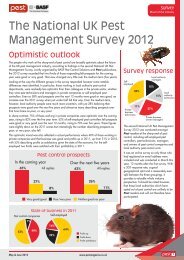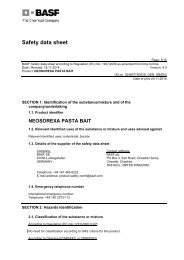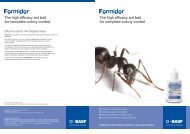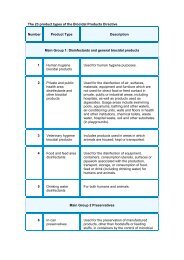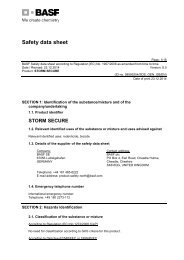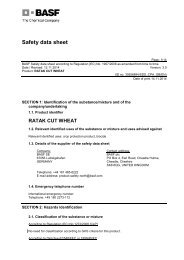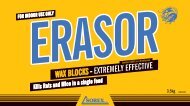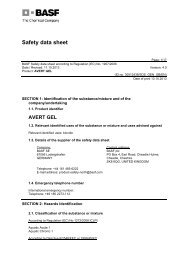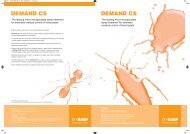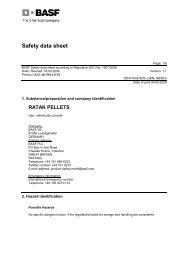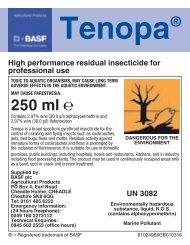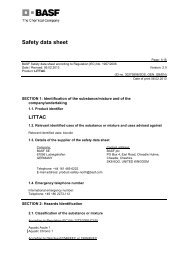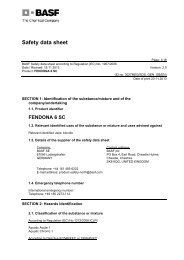Ant Control Guide - Pest Control Management - BASF
Ant Control Guide - Pest Control Management - BASF
Ant Control Guide - Pest Control Management - BASF
Create successful ePaper yourself
Turn your PDF publications into a flip-book with our unique Google optimized e-Paper software.
Best Practice<br />
European <strong>Ant</strong> <strong>Control</strong>.<br />
SMART<br />
GUIDE<br />
Enabling the most effective solutions to your pest problems.<br />
02976 - <strong>Ant</strong> <strong>Control</strong> UK <strong>Guide</strong> NB.indd 1 28/10/2014 13:20:07
The European <strong>Ant</strong> Challenge<br />
Biology and Behaviour<br />
One of the most successful of<br />
all insects, ants can be a serious<br />
nuisance pest in homes, hospitals,<br />
restaurants and other buildings.<br />
Their ubiquitous nature and social<br />
structure makes them particularly<br />
difficult to control.<br />
Of the 10,000-plus ant species known to exist, approximately 180 have been<br />
identified in Europe. The vast majority live outdoors where they perform a range<br />
of useful functions, including aerating the soil, controlling insect pests and<br />
breaking down organic matter.<br />
Problem Species<br />
Only a handful of ant species typically cause pest problems by virtue of their<br />
attraction to human and pet foods with high sugar and protein-contents.<br />
The most common of these sweet-feeding pest species are black garden ants<br />
(Lasius niger), yellow ants (Lasius flavus), red lasius ants (Lasius emarginatus) and<br />
pavement ants (Tetramorium caepsitum) all of which generally nest outdoors.<br />
Carpenter ants (Campanotus sp.), pharoah’s ants (Monomorium pharaonis) and<br />
argentine ants (Linepithema humile), which tend to nest in close proximity to or<br />
within buildings, can also be problematic in some cases.<br />
<strong>Ant</strong>s owe much of their success to their<br />
advanced social structure. Clear divisions<br />
of labour between workers – scouts,<br />
foragers, larvae feeders and sentries – as<br />
well as between workers, queens and<br />
drones (reproductive males) make for<br />
the most efficient colony establishment,<br />
development and survival.<br />
Exclusively responsible for egg-laying, queens<br />
(either an individual one for example in Lasius<br />
spp or 2 or more in species like Monomorium<br />
pharaonis) are completely dependent on<br />
foraging workers for their food supply. As are<br />
non-foraging workers, developing larvae and<br />
drones in the nest.<br />
Following scent originally laid down by<br />
scouts which range widely, hunting out new<br />
food sources within 100 yards or so of the<br />
nest, foraging workers continuously carry<br />
food back to the colony based in single or<br />
multiple sites, depending on species. As well<br />
as consuming it themselves, they share the<br />
food with all the non-foraging adults and<br />
developing larvae in a process known as<br />
trophallaxis.<br />
This results in the well-travelled ant trails<br />
between nest sites and their various food<br />
sources that characterise most infestations;<br />
trails that become more persistent and<br />
difficult to disrupt with increasing use.<br />
Research has shown that, while fewer<br />
individuals can feed on liquids than on gel<br />
or solid food sources at any time, foraging<br />
workers typically consume five times more of<br />
a liquid bait than they do of a gel.<br />
Mortality %<br />
Comparative ant mortality of 0.005% fipronil<br />
liquid and gel baits. (Silverman and Roulston 2001)<br />
50<br />
45<br />
40<br />
35<br />
30<br />
25<br />
20<br />
15<br />
10<br />
5<br />
0<br />
1 3<br />
Time (days)<br />
<strong>Control</strong> Approach<br />
The particular challenge presented<br />
by ants makes it important to tackle<br />
them with a behavior-led <strong>BASF</strong><br />
Integrated <strong>Pest</strong> <strong>Management</strong> strategy<br />
based around five key essentials:.<br />
1. Inspect to establish the extent and<br />
location of the infestation.<br />
2. Prescribe the best treatment strategy<br />
for the particular situation.<br />
3. Communicate to set the right<br />
expectations and gain sufficient<br />
co-operation.<br />
4. Treat using the most effective products<br />
in the best and safest ways.<br />
5. Follow-up to assess results, and<br />
re-treat if necessary.<br />
Gel<br />
Liquid<br />
Another likely natural consequence of their<br />
adaption to feed on honeydew, it has also<br />
been shown ants share baits consumed in<br />
a liquid form far more rapidly and efficiently<br />
within the colony. As a result, dramatically<br />
improved rates of control can be seen<br />
compared to an equivalent gel<br />
bait formulation.<br />
2 3<br />
02976 - <strong>Ant</strong> <strong>Control</strong> UK <strong>Guide</strong> NB.indd 2-3 28/10/2014 13:20:09
Tackling <strong>Ant</strong> Infestations<br />
Effective control of social insects like<br />
ants can only be achieved through<br />
measures which eliminate both queens<br />
and their broods. Exclusion of foraging<br />
workers from food sources or their<br />
elimination – either physically or by<br />
chemical treatment – is rarely, if ever,<br />
sufficient to give more than temporary<br />
respite from most infestations.<br />
Quality Baiting<br />
The only reliable way of ensuring complete<br />
control is to provide foraging workers with<br />
an attractive, powerful and readily-accessible<br />
insecticide bait which they both consume<br />
themselves and distribute throughout<br />
their colonies.<br />
This approach harnesses natural trophallactic<br />
ant behaviour to ensure all individuals –<br />
particularly queens and their larvae – receive a<br />
lethal dose of insecticide.<br />
Without it a combination of the existing brood<br />
(eggs, larvae and pupae) and the prodigious<br />
egg-laying capacity of the queens can easily<br />
bring infestations back to their original level<br />
within a few weeks of treatment.<br />
For the greatest effectiveness and reliability,<br />
the ant bait needs to be based on an<br />
insecticide which is:<br />
• Undetectable to all ants yet powerful enough<br />
to be lethal when ingested or physically<br />
transferred within the colony in minimal<br />
amounts; and,<br />
• Sufficiently delayed in its action to allow<br />
foraging workers to distribute it widely to all<br />
adults and larvae within the colony before<br />
succumbing.<br />
The bait formulation must further be:<br />
• Highly attractive and appealing to ants to<br />
stimulate the greatest possible worker feeding;<br />
and,<br />
• In liquid form to ensure the most rapid and<br />
effective active ingredient uptake<br />
and redistribution throughout the colony.<br />
Good baiting practice is equally critical to<br />
success. In particular:<br />
• Indoor areas should be cleaned and alternative<br />
food sources removed<br />
before treatment;<br />
• Baits should be placed where they will not be<br />
rapidly removed by cleaning, and preferably<br />
close to known or suspected ant access points<br />
and foraging trails;<br />
• Areas previously treated with repellent<br />
insecticides should be avoided;<br />
• Outside baiting should be focused on active<br />
ant foraging trails, with bait points placed as<br />
close to nest sites as possible; and,<br />
• Bait should be placed on non-porous surfaces<br />
and protected from rain, ideally in specialist<br />
bait stations<br />
Support Spraying<br />
<strong>Ant</strong> baiting will typically take between 10-14<br />
days to give colony control. So where rapid<br />
elimination of foraging individuals is important<br />
in sensitive locations it may need to be<br />
complemented with tactical spraying of a<br />
fast-acting insecticide.<br />
As well as rapidly eliminating visible indoor<br />
foraging ants, an insecticide with a repellent<br />
nature can also act as a useful perimeter barrier<br />
to further ant entry.<br />
It is important to note though that repellant<br />
insecticides should not be used close to bait<br />
treatments as their repellant nature may prevent<br />
ants coming into contact with the bait.<br />
Spraying should:<br />
• Be targeted at indoor ant trails and wall/floor<br />
junctions in the vicinity of food sources;<br />
• Include typical entry sites around windows<br />
and doors, drains and pipe runs; and,<br />
• Avoid external ant trails in the vicinity of<br />
baiting points.<br />
It is important to appreciate that ants are<br />
extraordinarily persistent in following trails to<br />
food and small enough to gain entry through<br />
even the tiniest of openings.<br />
This makes thorough perimeter treatment with<br />
repellent insecticides vital to ensure effective<br />
exclusion as well as immediate elimination<br />
of obvious signs of infestation while baiting<br />
achieves its full colony control effect.<br />
Where infestations are large, well-established<br />
or otherwise particularly challenging, external<br />
spraying of nests and ant trails with a<br />
slower-acting, non-repellent insecticide will<br />
be valuable.<br />
Physical <strong>Control</strong>s<br />
Although generally ineffective on their own,<br />
physical means of excluding ants from<br />
buildings or food sources can be valuable<br />
alongside chemical controls too, especially<br />
in guarding against re-infestation from new<br />
colonies around sensitive locations.<br />
The most effective measures include:<br />
• <strong>Ant</strong>-proof storage of foods in truly<br />
sealable containers;<br />
• Regular cleaning of floors and surfaces<br />
to remove spillages and scent trails;<br />
• Good disposal of kitchen scraps and<br />
food waste; and,<br />
• Permanent sealing of access points<br />
with flexible caulk.<br />
4 5<br />
02976 - <strong>Ant</strong> <strong>Control</strong> UK <strong>Guide</strong> NB.indd 4-5 28/10/2014 13:20:14
Treatment Programmes<br />
Based on a combination of internal, external<br />
and perimeter treatment, the most effective<br />
ant treatment programmes involve:<br />
• Thoroughly inspecting the premises in dry<br />
weather to identify the level of infestation,<br />
species of ant (where possible), main trails<br />
and access points.<br />
• Tracing external ant runs as far back to<br />
the nest as feasible, bearing in mind that<br />
trails may be very difficult to locate when<br />
conditions are wet.<br />
• Placing sufficient specialist liquid<br />
Formidor ® ant bait along external ant<br />
runs, using specialist bait stations or<br />
other weather protections.<br />
• Placing additional Formidor ® bait<br />
points at perimeter access points and<br />
along internal ant trails in locations<br />
least likely to be cleaned away wherever<br />
immediate visible pest elimination is<br />
not the overriding priority.<br />
• Thoroughly spraying Fendona ® SC along<br />
indoor trails and perimeter access points<br />
to complement external Formidor ® baiting<br />
in sensitive locations requiring immediate<br />
visible pest elimination.<br />
• Fully informing customers of the<br />
programme and the location of indoor<br />
baiting points in particular, warning them<br />
not to clean them away or use<br />
aerosol insecticides near them.<br />
• Returning 2-4 weeks after treatment<br />
to check for any continuing signs of<br />
infestation, replenishing bait points if<br />
they are empty and ants are still visible.<br />
• Advising customers on effective<br />
physical controls to minimise the<br />
danger of re-infestation.<br />
Programme Summary<br />
Inside<br />
Perimeter<br />
Outside<br />
Standard<br />
Treatment<br />
Sensitive Locations<br />
Requiring immediate<br />
ant elimination<br />
6 7<br />
02976 - <strong>Ant</strong> <strong>Control</strong> UK <strong>Guide</strong> NB.indd 6-7 28/10/2014 13:20:16
General Domestic Treatment<br />
Example of how Formidor ® can be utilised in a typical domestic situation to<br />
gain control of ants both indoors and outdoors.<br />
Commercial Treatment<br />
Example of how Fendona ® SC can be utilised as a supportive spray<br />
treatment, to deliver rapid elimination of foraging individuals in public areas, in<br />
combination with a Formidor ® treatment to deliver colony control.<br />
Formidor ®<br />
Formidor ®<br />
Fendona ® SC<br />
8 9<br />
02976 - <strong>Ant</strong> <strong>Control</strong> UK <strong>Guide</strong> NB.indd 8-9 28/10/2014 13:20:17
Making the Most of the Products<br />
High performance <strong>BASF</strong> insecticides provide European pest controllers with the most<br />
reliable way of controlling sweet feeding ants in any situation.<br />
Formidor ®<br />
Formidor ® brings the low dose killing power of fipronil – wellproven<br />
in the leading cockroach bait, Goliath ® Gel – to the<br />
professional ant control market.<br />
Lethal to adult ants and larvae in tiny amounts, it has a completely<br />
different mode of action to other baits, making it especially<br />
valuable in anti-resistance strategies.<br />
Building on research showing the clear superiority of liquid baits<br />
over gels and solids in both worker uptake and trophallaxis,<br />
Formidor ® is formulated as a sugar rich liquid.<br />
It is irresistible to ants – which cannot detect the insecticide –<br />
and maintains its attractiveness over an extended period, leading<br />
to ready consumption and rapid transfer back to the nest.<br />
The 0.05% concentration of fipronil is carefully engineered to<br />
affect ants from 12-24 hours after consumption. This gives<br />
workers sufficient time to share the bait widely with other adults<br />
as well as larvae and queens before starting to succumb.<br />
Formidor ® is most effective against Lasius and other species<br />
of the sub-family Formicinae. It causes colony collapse within<br />
10-14 days of treatment, giving more rapid and consistent colony<br />
control than other common ant killers.<br />
Mortality (%)<br />
120<br />
100<br />
80<br />
60<br />
40<br />
20<br />
0<br />
Efficacy of 3 active ingredients for lasius niger colony control<br />
0 3 7 10 14<br />
Time (Days)<br />
Fenitrothion<br />
Imidacloprid<br />
Fipronil<br />
Fendona ® SC<br />
Fendona ® SC should be the first choice supporting spray<br />
treatment where immediate visible pest elimination is required.<br />
Its advanced, low dose, alpha-cypermethrin formulation delivers<br />
knockdown in as little as 30 minutes, excellent coverage and<br />
reliable residuality even on difficult surfaces.<br />
Micro-particles that cling to the legs and antennae sensitise ants<br />
on contact, making the spray particularly valuable as a perimeter<br />
barrier.<br />
As well as being virtually odourless and non-staining, it has very<br />
low toxicity to humans and other warm-blooded animals for the<br />
greatest safety and acceptability in indoor use.<br />
Fendona ® SC is supplied in 500 ml bottles containing 60g/l of<br />
alpha-cypermethrin as a water-based suspension concentrate for<br />
dilution with water at the rate of 5 ml/litre and application through<br />
all standard knapsack or hand-held sprayers as a coarse, low<br />
pressure spray.<br />
It should be applied to all internal ant foraging trails, wall/floor<br />
junctions near food sources and around doors, windows, drains<br />
and other perimeter access points.<br />
Key <strong>Ant</strong> Treatment <strong>Guide</strong>lines<br />
Thorough inspection in dry weather is vital to trace external as well as<br />
internal ant trails.<br />
Quality insecticide baiting is the only reliable route to complete colony control.<br />
In addition to being attractive and powerful, the bait needs to have a sufficiently<br />
delayed action to allow the widest sharing throughout the colony.<br />
Liquid formulations are far more effective than gels in getting insecticide baits<br />
into colonies, despite gels attracting greater levels of visible feeding.<br />
In sensitive locations requiring immediate visible control, indoor<br />
and perimeter spraying with a fast-acting insecticide may be needed<br />
alongside baiting.<br />
Where colonies are large and well-established, nest and external<br />
spraying with a powerful insecticide may be valuable alongside baiting.<br />
Repellent insecticides should never be used in close proximity to<br />
baiting points.<br />
Good customer communication is essential to set control expectations<br />
and avoid unintentional interference with treatments.<br />
A follow-up visit 2-4 weeks after treatment is always advisable to check on<br />
control, show customer care and to provide guidance on proofing to against<br />
future infestations.<br />
10 11<br />
02976 - <strong>Ant</strong> <strong>Control</strong> UK <strong>Guide</strong> NB.indd 10-11 28/10/2014 13:20:20
Formidor ® contains fipronil.<br />
Fendona ® contains alpha-cypermethrin.<br />
Formidor ® and Fendona ® are registered trademarks of <strong>BASF</strong>.<br />
Use biocides safely. Always read the label and product information before use.<br />
Further information from:<br />
<strong>BASF</strong> Plc, Professional and Specialty Solutions - Urban and Rural <strong>Pest</strong> <strong>Control</strong><br />
PO Box 4, Earl Road ,Cheadle Hulme, Cheadle, Cheshire, SK8 6QG<br />
Tel: 0161 488 5355<br />
Fax: 0161 485 1137<br />
Email: pestinfo@basf.com<br />
www.pestcontrol.basf.co.uk<br />
02976 - <strong>Ant</strong> <strong>Control</strong> UK <strong>Guide</strong> NB.indd 12 28/10/2014 13:20:24




